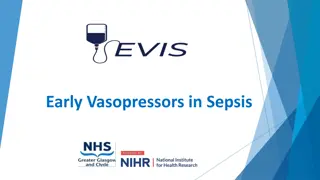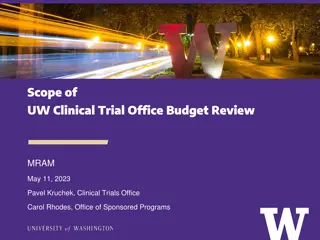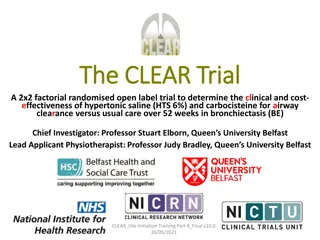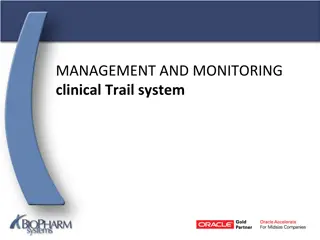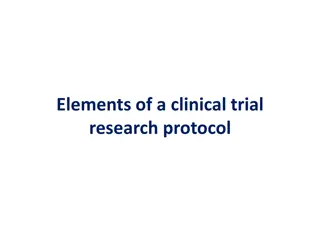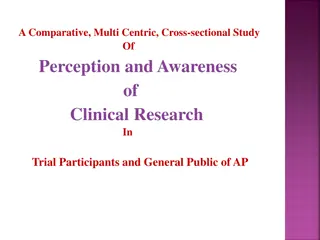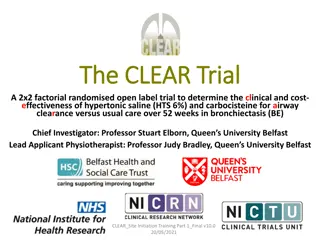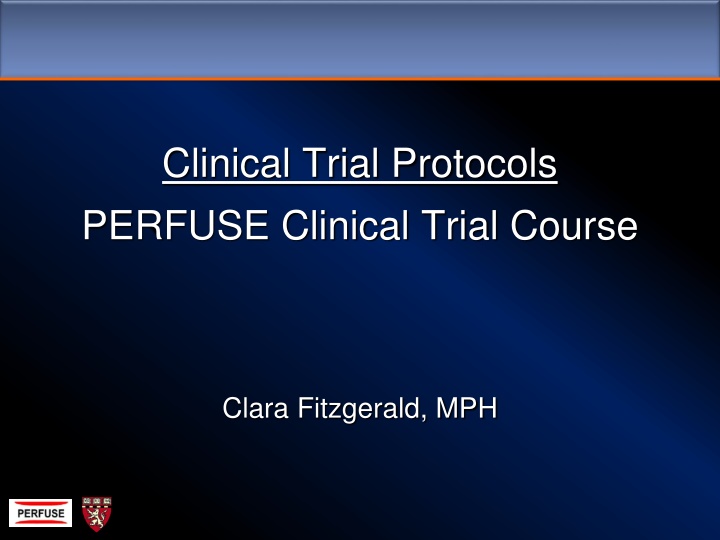
Clinical Trial Protocols for Effective Research Planning
Dive into the world of clinical trial protocols with insights on protocol design, key elements, interdisciplinary team collaboration, and the crucial role they play in ensuring consistency in data collection and study progress. Explore the phases of clinical trials and the essential components of a protocol table of contents to enhance your understanding of this fundamental aspect of research methodology.
Download Presentation

Please find below an Image/Link to download the presentation.
The content on the website is provided AS IS for your information and personal use only. It may not be sold, licensed, or shared on other websites without obtaining consent from the author. If you encounter any issues during the download, it is possible that the publisher has removed the file from their server.
You are allowed to download the files provided on this website for personal or commercial use, subject to the condition that they are used lawfully. All files are the property of their respective owners.
The content on the website is provided AS IS for your information and personal use only. It may not be sold, licensed, or shared on other websites without obtaining consent from the author.
E N D
Presentation Transcript
Clinical Trial Protocols PERFUSE Clinical Trial Course Clara Fitzgerald, MPH
Lecture Part Part 1 Topic Presenter Introduction: Principles of Protocol Design and Development Protocol Overview: Protocol Elements / Table of Contents Statistical Methods, Eligibility & Design Subject Enrollment & Randomization Clara Clara Clara Arzu Part 2 Study Procedure & Intervention Details Data: Clinical Protocol Assessments & Data Collection Case Report Forms Clinical Protocol Amendments and Violations Resources for Clinical Protocol Development Arzu Gerry Part 3 Gerry Clara Clara Part 4
Goals of Clinical Study Protocols What is a Clinical Study Protocol? A complete written description of, and scientific rationale for, research involving human subjects Objectives: Road map for operationalizing study Consistency of Data Collection Facilitates communications among interdisciplinary team Assist in manuscript authorship and preparation
Protocol Establishes Mutual Understanding and Agreement
Interdisciplinary Team Protocol development should include an interdisciplinary team: - Investigator - Sponsor - Statistician - Clinical Team - Study Staff
Clinical Trial Phases & Protocols Goal & structure of the Protocol will mirror the objective of clinical trial phase Phase 1 Safety Phase 2 Efficacy & Safety Phase 3 Validation of Efficacy and Safety
Key Protocol Elements Table of Contents Template
Statistical Analysis Section Statistical Methods & Considerations Data Sets Analysis of Primary Endpoint Analysis of Secondary Endpoint Interim Analysis Sample Size and Power Sample Size and Power Calculation may determine study feasibility Ensure required number of subjects fits budget and timeline
Sample Size and Power Determination Factors important in Sample Size Analysis Significance level of the test (alpha) Usually 0.05 Power Usually between 0.8 and 0.9 80% probability that you will correctly reject null hypothesis Estimated effect size The difference of two group means divided by the pooled standard deviation From previous studies Sample size Required number of patients Important to consider: Loss to follow up Lack of compliance Clinical significance vs. statistical significance
Statistical Analysis Section Statistical Methods & Considerations Data Sets Analysis of Primary Endpoint Analysis of Secondary Endpoint Interim Analysis Sample Size and Randomization
Overview of Analysis Sets Full Analysis Set Per- Protocol Safety Intent to Treat (ITT) Principle- every patient randomized enters the primary analysis Patients that have completed satisfactory compliance with treatment (no major protocol violations or deviations) As treated principle- Patients that received any study treatment, actual treatment received Patients Included: Provide estimates which are more likely to mirror real word clinical practice Avoid bias that may be caused by exclusion of patients Aims to identify a treatment effect which would occur under optimal conditions i.e. all patients are compliant To analyze safety, including adverse events, toxicity and laboratory evaluations Aim: Full analysis set (FAS) or As randomized Per-protocol set (PPS), efficacy sample or evaluable subjects sample Safety set Referred to As: All Efficacy Analyses Sensitivity Analyses Safety Analyses Used for:
Statistical Analysis Section Statistical Methods & Considerations Data Sets Analysis of Primary Endpoint Analysis of Secondary Endpoint Interim Analysis Sample Size and Randomization
Statistical Analysis Section Statistical Methods & Considerations Data Sets Analysis of Primary Endpoint Analysis of Secondary Endpoint Interim Analysis Sample Size and Randomization
Overview of Interim Analysis Why perform Interim Analysis During a clinical trial? Analyses for Safety, Efficacy, Futility or sample size re-estimation Reduce subject exposure to inferior or harmful treatment Ensure efficient use of resources Who performs an Interim Analysis? Data Safety Monitoring Board (DSMB) or Independent Data Monitoring Committee (IDMC) In independent group of experts that reviews accumulating data at specified time points and advises the Steering Committee What information is included in the Clinical Study Protocol for the Interim Analysis? All details about the timing, frequency and methods should be specified in the trial protocol before the study begins



